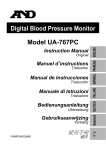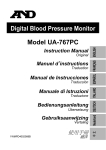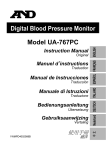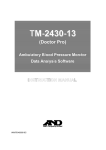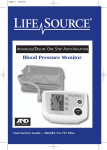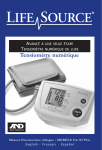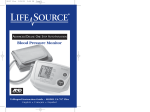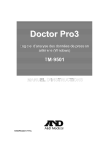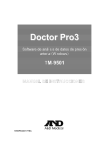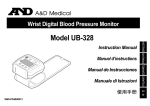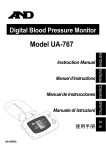Download A&D UA-767PC Instruction manual
Transcript
Digital Blood Pressure Monitor UA-767PC 1WMPD4000034E Instruction Manual Contents Dear Customers .....................................................................................................3 Preliminary Remarks ..............................................................................................3 Precautions.............................................................................................................3 Parts Identification ..................................................................................................4 Symbols..................................................................................................................5 Setting the Clock ....................................................................................................6 Preparation for Measurements ...............................................................................7 1. Installing / Changing the Batteries ...............................................................7 2. Connecting the Air Hose ..............................................................................7 3. Attaching the Arm Cuff.................................................................................7 4. How To Take Proper Measurements ...........................................................7 5. Measurement...............................................................................................7 6. After the Measurement ................................................................................7 Measurements........................................................................................................8 Notes for Proper Measurements .......................................................................10 Data in Memory ....................................................................................................11 Storing Data in Memory ....................................................................................11 Recalling Memory Data.....................................................................................11 Erasing Data in Memory ...................................................................................11 Transmitting Readings to a Computer ..................................................................12 About Blood Pressure...........................................................................................13 What Is Blood Pressure? ..................................................................................13 What Is Hypertension And How Is It Controlled? ..............................................13 Why Measure Blood Pressure At Home? .........................................................13 WHO Blood Pressure Classification..................................................................13 Blood Pressure Variations ................................................................................13 Troubleshooting....................................................................................................14 Maintenance .........................................................................................................15 Technical Data......................................................................................................15 2 Dear Customers Congratulations on purchasing a state-of-the-art A&D blood pressure monitor, one of the most advanced monitors available today. Designed for ease of use and accuracy, this monitor will facilitate your daily blood pressure regimen. We recommend that you read through this manual carefully before using the device for the first time. Preliminary Remarks The device conforms to the following requirements: European Directive 93/42 EEC for Medical Products Act; Medical Products Act; European Standards for Electrical Medical Equipment EN 60601-1 (General Safety Provisions), EN 60601-1-2 and EN 55011 (Electromagnetic Compatibility); European Standards pertaining to Non Invasive Blood Pressure Instruments EN 1060-1(General Requirements), EN 1060-3 (Supplementary Requirements for Electromechanical Blood Pressure Measuring Systems). The above is evidenced by the mark of conformity. (0366: The reference number to the involved notified body) The device is designed for use on adults only, not newborns or infants. Environment for use The device is for use indoors. Precautions Precision components are used in the construction of this device. Extremes in temperature, humidity, direct sunlight, shock or dust should be avoided. Clean the device with a soft, dry cloth. Never use thinner, alcohol, benzine, or a wet cloth. Avoid tightly folding the cuff or storing the hose tightly twisted for long periods, as such treatment may shorten the life of the components. The device and cuff are not water resistant. Prevent rain, sweat and water from soiling the device and cuff. Measurements may be distorted if the device is used close to televisions, microwave ovens, cellular telephones, X-ray or other devices with strong electrical fields. Used equipment, parts and batteries are not treated as ordinary household waste, and must be disposed of according to the applicable local regulations. 3 Parts Identification Data Port Systolic Display Air Socket Pressure Switch Measurement in Progress Diastolic Display Clock Button Memory Access Indicator Start Button Pulse Display Clock Display Low Battery Display Air Connector Plug Arm Cuff Air Hose 1.5V Batteries (R6P, LR6 or AA) 4 Symbols Symbols Function / Meaning Treatment Turns on or off the device Sets the clock / Does not store the current data Direction guide to install battery Direct current SN Serial number Date of manufacture Type BF: Device, cuff and tubing are designed to provide special protection against electric shocks. Appears when measurement is in progress and flashes when the pulse is detected. Previous measurement stored in MEMORY Appears when the battery voltage is too low for the device to work properly. Appears if the systolic and diastolic measurements are within 10 mmHg of each other. Appears if the pressure value is unstable due to movement during the measurement. Appears if the pressure value did not increase during pump up. Measurement is in progress -remain as still as possible. Replace all batteries with new ones. Verify that the air hose is properly connected and that the exhaust rate is between 2 and 5 mmHg. Check for air leakage. Try the measurement again. Remain very still during the measurement. Verify that the air hose is properly connected and that the exhaust rate is between 2 and 5 mmHg. Check for air leakage. System error Reload batteries. Appears if pulses are not detected correctly. Attach the cuff properly and try the measurement again. Attention symbol See instruction for use EC directive medical device label WEEE label 5 Setting the Clock The UA-767PC blood pressure monitor is equipped with a date and time function. To set the clock on the monitor, follow these steps: Press the clock button on the front of the monitor. The blinking digits reflect the year. If they are not currently set on the correct year, press the START button to advance to the correct year. The clock is set to show years 1999 through 2098. If you pass the correct year, continue advancing the clock until you have run through the cycle of years and are back at the correct year. Year To set the month and day, press the clock button again. The month numeral(s) will blink. Press the START button to advance the numbers to the correct month. Press the clock button again to advance to the day setting. When the numbers reflecting the day of the month blink, press the START button to advance the numbers to the correct day. Month/Day When you press the clock button again, the display will change and the time will be shown in the same format as a digital clock, with the hour numerals blinking. To set the correct hour, press the START button to advance the numbers to the correct hour. To set the minutes, press the clock button again. The minute setting will blink. Press the START button to advance the minutes until you reach the correct setting. Press the clock again. The hour and minute display appears. This is the standby mode. Hour/Minute 6 Preparation for Measurements 1. Installing / Changing the Batteries Remove the battery cover and insert new batteries into the battery compartment as shown, taking care to observe the proper direction for each battery. Use R6P, LR6 or similar type batteries. If the symbol appears on the display panel, this means that the batteries are depleted. Always change all batteries at the same time. If you do not intend to use the device for longer periods, remove the batteries. Only use high quality, leakproof batteries with the specified ratings. Never mix new and old batteries or batteries from different manufacturers. Note: Used equipment, parts, batteries do not fall within the category of household waste, and must be disposed of according to the applicable regulations. 2. Connecting the Air Hose Insert the air connector plug firmly into the air socket. Cuff Left arm 3. Attaching the Arm Cuff Wrap the cuff around the upper arm about 2-3 cm (1 inch) above the elbow as shown. Place the cuff directly against the skin, as clothing may cause a faint heart beat, and result in an error. Constriction of the upper arm caused by rolling up a shirt sleeve may prevent accurate readings. Hose 2-3 cm (1 inch) Excessive constriction 4. How To Take Proper Measurements For the most accurate blood pressure measurement: Sit comfortably at a table. Rest your arm on the table. Relax for about five to ten minutes before measurement. Place the center of the cuff at the same height as your heart. Remain still and keep quiet during measurement. Do not measure right after physical exercise or a bath. Rest for twenty or thirty minutes before taking the measurement. Try to measure your blood pressure at the same time every day. 5. Measurement During the measurement, the cuff will become very tight. Do not be alarmed as this is normal. 6. After the Measurement After the measurement, remove the cuff and record your data. 7 Measurements 1. Place the cuff on the arm (preferably the left arm). 2. Set the PRESSURE switch to a value that will be 30 to 40 mmHg above the expected systolic value and press the START button. When the START button is pressed, all of the display symbols will appear for about one second. When the "0" is blinking, the device is calibrating its zero point. If there is still some air in the arm cuff, it will be exhausted at this time. The micro pump will pressurize the cuff. Note: The cuff will become very tight. Do not be alarmed, as this is normal. If the START button or clock button is pressed again during pressurization or during the measurement, the pump will stop and the air will be released from the cuff. 3. When pressurization has been completed, the automatic exhaust mechanism will gradually reduce the pressure in the cuff and the Measurement in Progress symbol will appear along with the current pressure reading. This symbol will flash in unison with the pulse of the person being monitored. Measurement in Progress 8 Measurements Remain still while the device is in operation. When a measurement is made with insufficient pressure, the device will pump again to a higher pressure. 4. When measurement has been completed, the buzzer sounds and the air is automatically released from the cuff. The systolic pressure, diastolic pressure readings, and the pulse rate are displayed. Systolic Display Pressure Switch Diastolic Display Start Button Pulse Display 5. Turning the Power OFF Press the START button to turn the power off. The device will be in standby mode. 6. Subsequent Measurements If a subsequent measurement is required, turn off the power and turn it on again. When the "0" is displayed, the device is ready for measurement again. Note: Please wait for about 10 minutes before repeating the measurement. 7. Automatic Power OFF Function If this device is left on after a measurement, it will turn itself off after about 1 minute. It may be turned off at any time by pressing the START button. 9 Measurements Accurate measurement cannot be made if the exhaust velocity is outside the range of 2 to 5 mmHg. This can be determined by watching the display each time the "Measurement in Progress" symbol blinks. Note the reading as the "Measurement in Progress" symbol blinks. Notes for Proper Measurements Sit in a comfortable position where you can place the arm to be used for the measurement on a table or other support that will place the center of the upper arm at about the same height as your heart. Relax for about 5 or 10 minutes before starting the measurement. If you are excited or depressed by emotional stress, the measurement will reflect this stress as a higher (or lower) than normal blood pressure reading, the pulse reading will usually be faster than normal. A normal person's blood pressure varies constantly depending on what you are doing and on what you have eaten. What you drink can have a very strong and rapid affect on your blood pressure. As this device bases its measurements on the heart beat, if you have a very weak or irregular heart beat, the device may have difficulty determining your proper blood pressure. Should the device detect a condition that is abnormal, it will stop the measurement and display an error. See the section on description of display symbols for details. This blood pressure device is intended for use by adults only. Consult with your physician before using this device on a child. A child should not use this device unattended. 10 Data in Memory Storing Data in Memory This device can automatically store up to 280 sets of measurement data in its memory. If an error message appears, the measurement data will not be stored. Whether the data will be stored or not after the measurement can be selected as follows: When the START button is pressed or the automatic power OFF function works after a measurement, the measurement data will be stored in memory. When the clock button is pressed after a measurement, the measurement data will not be stored in memory. Recalling Memory Data 1. To access measurements stored in memory, wait until the monitor is in standby mode. 2. Press and hold the START button until the display shows the most recent measurement. 3. The display will show all of the stored measurements starting with the most recent and then will return to standby mode. To interrupt memory display, press the START button to initiate inflation mode. To put the monitor in standby mode, press the START button again. Erasing Data in Memory 1. To erase measurements stored in memory, wait until the monitor is in standby mode. 2. Press and hold the clock button until the buzzer sounds and the memory access indicator blinks. All data in memory will be erased. 11 Transmitting Readings to a Computer The connected computer is not permitted to be in the patient area. To transmit the readings to a computer, connect the attached communication cable to the data port on the front of the monitor. When the monitor receives the open command, it will be in the ready-to-send mode. When the monitor receives the open command again within five seconds, “-“ appears one after another in succession and permission will be given to perform various functions. Measurement data of the UA-767PC can be monitored with “Monitor Pro” Data Analysis Software (UA-767P-13) and Printer terminal (TM-2480 series). For details, refer to the instruction manual. Note: UA-767P-13 and TM-2480 are sold separately. Standby mode Ready-to-send mode When the open command is Receives the received again within 5 seconds, open command "-" appears one after another. The command table operation such as setting time and obtaining measurement data will be permitted. Start-to-measure command After a measurement Starts a measurement Close command Standby mode 12 About Blood Pressure What Is Blood Pressure? Blood pressure is the force exerted by blood against the walls of the arteries. Systolic pressure occurs when the heart contracts. Diastolic pressure occurs when the heart expands. Blood pressure is measured in millimeters of mercury (mmHg). One's natural blood pressure is represented by the fundamental pressure, which is measured first thing in the morning while one is still at rest and before eating. What Is Hypertension And How Is It Controlled? Hypertension, which is abnormally high arterial blood pressure, if left unattended, can cause many health problems including stroke and heart attack. Hypertension can be controlled by altering one's lifestyle, avoiding stress, and with medication under a doctor’s supervision. To prevent hypertension or keep it under control: Do not smoke Exercise regularly Reduce salt and fat intake Have regular physical checkups Maintain proper weight Why Measure Blood Pressure At Home? Blood pressure measured at a clinic or doctor's office may cause worry or apprehension and can produce an elevated reading, 25 to 30 mmHg higher than that measured at home. Home measurement reduces the effects of outside influences on blood pressure readings, supplements the doctor's readings and provides a more accurate, complete blood pressure history. WHO Blood Pressure Classification Standards to assess high blood pressure, without regard to age, have been established by the World Health Organization (WHO), as shown in the chart. Blood Pressure Variations An individual’s blood pressure varies greatly on a daily and seasonal basis. It may vary by 30 to 50 mmHg due to various conditions during the day. In hypertensive individuals, variations are even more pronounced. Normally, the blood pressure rises while at work or play and falls to its lowest levels during sleep. So, do not be overly concerned by the results of one measurement. Take measurements at the same time every day using the procedure described in this manual to get to know your normal blood pressure. Regular readings give a more comprehensive blood pressure history. Be sure to note date and time 13 when recording your blood pressure. Consult your doctor to interpret your blood pressure data. Troubleshooting Problem Nothing appears in the display, even when the power is turned on. The cuff does not inflate. The unit is not operating properly. Readings are too high or too low. Other Possible Reason Batteries are drained. Battery terminals are not in the correct position. Battery voltage is too low. (LOW BATTERY mark) blinks. If the batteries are drained completely, the mark does not appear. The cuff is not fastened properly. You moved your arm or body during the measurement. The cuff position is not correct. The value is different from that measured at a clinic or doctor’s office. Recommended Action Replace all batteries with new ones. Reinstall the batteries with negative and positive terminals matching those indicated on the battery compartment. Replace all batteries with new ones. Fasten the cuff correctly. Make sure you remain very still and quiet during the measurement. Sit comfortably and still. Raise your hand so that the cuff is at the same level as your heart. If you have a very weak or irregular heat beat, the device may have difficulty in determining your blood pressure. See “Why measure blood pressure at home”. Remove the batteries. Replace them properly and try the measurement again. Note: If the actions described above do not solve the problem, contact the dealer. Do not attempt to open or repair this product, as any attempt to do so will make your warranty invalid. 14 Maintenance Do not open the device. It uses delicate electrical components and an intricate air unit that could be damaged. If you cannot fix the problem using the troubleshooting instructions, request service from your dealer or from the A&D service group. The A&D service group will provide technical information, spare parts and units to authorized dealers. The device was designed and manufactured for a long service life. However it is generally recommended to have the monitor inspected every 2 years, to ensure proper functioning and accuracy. Please contact either your authorized dealer or A&D for maintenance. Technical Data Type UA-767PC Measurement method Oscillometric measurement Measurement range Pressure: 20 - 280 mmHg Pulse: 40 - 200 beats / minute Accuracy Pressure: ±3 mmHg or 2%, whichever is greater Pulse: ±5% Battery 4 x 1.5V (R6P, LR6, or AA) Cuff Arm Circumference Classification Type BF 0366 Device, cuff and tubing are designed to provide special protection against electric shocks. Clinical test According to ANSI / AAMI SP-10 1987 Standard deviation Mean error Systolic blood pressure 5.43 mmHg 2.24 mmHg Diastolic blood pressure 5.18 mmHg 1.54 mmHg Memory Last 280 measurements Operating environment +10 °C to +40 °C, 30%RH to 85 %RH Storage environment −10 °C to +60 °C, 30%RH to 85 %RH Dimensions 163.7 [W] x 111 [D] x 66.7 [H] mm Weight Approx. 320g without batteries Note: Specifications are subject to change without prior notice. 15 A&D Co.,Ltd. 1-243 Asahi, Kitamoto-shi, Saitama 364-8585 JAPAN Telephone: [81] (48) 593-1111 Fax: [81] (48) 593-1119 A&D ENGINEERING, INC. 1756 Automation Parkway, San Jose, CA. 95131 U.S.A. Telephone: [1] (408) 263-5333 Fax: [1] (408)263-0119 A&D INSTRUMENTS LTD. <Authorized Representative Established in the European Community> Unit 24/26 Blacklands Way, Abingdon Business Park, Abingdon, Oxon OX14 1DY United Kingdom Telephone: [44] (1235) 550420 Fax: [44] (1235) 550485 A&D MERCURY PTY. LTD. 32 Dew Street, Thebarton, South Australia 5031 AUSTRALIA Telephone: [61] (8) 8301-8100 Fax: [61] (8) 8352-7409
















